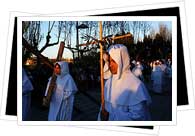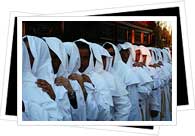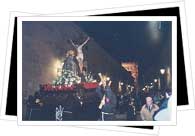When: March / April
 Where: You can catch the processions pretty much anywhere in Salamanca, although you'll see the most Semana Santa action in the Plaza Mayor and Salamanca University quarters. Come Lunes de Aguas, however, the place to be is along the banks of the Tormes River.
Where: You can catch the processions pretty much anywhere in Salamanca, although you'll see the most Semana Santa action in the Plaza Mayor and Salamanca University quarters. Come Lunes de Aguas, however, the place to be is along the banks of the Tormes River.
Semana Santa Traditions:
Declared an event of "Interés Turístico Internacional" (International Touristic Interest), Salamanca provides a magnificent background for one of the most celebrated festivals in Spain: Semana Santa (Holy Week). Passing by the city's golden Plateresque façades, Romanesque churches, and Baroque convents, the music and tradition of the processions is an experience unique to Spain.
 Each procession counts with an extensive entourage of figures. Rows upon rows of hooded penitents ("nazarenos") carry crosses and candles while young men- called "costaleros"- carry the elaborate floats upon their shoulders, moving to the beat of the soulful music played by brass and percussion bands. Upon the floats, which themselves are flower-laden marvels, are expressive figures of the Virgin, of Christ, and of entire scenes of the Passion. While the tradition has taken on a more festive tone in much of Spain, Salamanca's Semana Santa maintains an unique atmosphere of austeriy and meditation which makes for an extremely moving experience.
Each procession counts with an extensive entourage of figures. Rows upon rows of hooded penitents ("nazarenos") carry crosses and candles while young men- called "costaleros"- carry the elaborate floats upon their shoulders, moving to the beat of the soulful music played by brass and percussion bands. Upon the floats, which themselves are flower-laden marvels, are expressive figures of the Virgin, of Christ, and of entire scenes of the Passion. While the tradition has taken on a more festive tone in much of Spain, Salamanca's Semana Santa maintains an unique atmosphere of austeriy and meditation which makes for an extremely moving experience.
One of the most unique traditions of Salamanca's Semana Santa is on Holy Thursday with "Los Oficios," a ceremony featuring a mix of the academic and the liturgical. Held in the Catedral Vieja (Old Cathedral), all of the university professors attend dresed in their academic robes and take turns holding a lighted candle in an act that has never been cancelled- even during the epoch in which Semana Santa was. Originally intended to lure worshippers, the ceremony traditionally includes a breafkast of hot chocolate and cakes- a practice which is still upheld today!
Another featured tradition of the Salamanca Semana Santa is called the "Descendimiento de Cristo" (Descent of Christ), held on Good Friday. On Good Friday, all of the city's convents and churches remain open all day- a great opportunity to pop in for a visit! However, more importantly, is in the Patio Chico (small courtyard) between the two cathedrals, three crosses are erected in the portal of the Catedral Vieja. Christ is taken down from the center cross, placed in a glass sepulcher, and then processed through the city. Two days later, on Easter Sunday, is the moving "Acto del Reencuentro." Taking place in the Plaza de Anaya, the mourning Virgin is shed of her black cloak and she "meets" with the figure of her risen son in a happy, festive moment.
On the Monday following Easter, called "Lunes de Aguas" (Water Monday), friends and family meet at the river's shores in what is essentially a huge picnic. After the traditionally strict 40 days of Lent and the solemn Semana Santa, Lunes de Aguas is spent relaxing, having fun, and eating "hornazo"- a pastry pie filled with ham, sausage, bacon, cooked egg, and sometimes even chicken. Learn more about the surprising history of Lunes de Aguas below!
Semana Santa History:
Following the death of Christ, the next important date in the history of Salamanca's Semana Santa is in 1240, when the city's first "cofradía," or brotherhood, was formed. Originally called "Los Hermanos de la Penitencia en Cristo," (The Brothers of Penitence in Christ), the religious group would later become the "Cofradía de la Santa Cruz" (Brotherhood of the Holy Cross), a brotherhood that continues to exist and partake in the celebrations today.
1521 was another decisive year as the Marqués de Tarifa (Marquis of Tarifa) returned from the Holy Land with a whole new perspective that he was anxious to spread. Feeling inspired and religious after his journey, he institutionalized the Vía Crucis (Stations of the Cross) and mandated that it be commemorated each year with a procession. The single procession held on one day each yearr eventually broke up into various processions, each depicting a scene of the passion, which began to spread out over the course of the Semana Santa (Holy Week) while the simple crosses and altars evolved into the elaborate floats that we see today.
 The history of Lunes de Aguas (Water Monday) is a rather curious story, to say the least. Back in the day, along with a prestigious university, Salamanca also had a well-known red light district where prostitutes practiced- so to speak- with the university students, hoping to eventually make it to the royal courts. Well, in the 16th century, King Felipe II, who was known as a very serious and devout Catholic, was disgusted with the marginal activities taking place in the prominant academic and religious hub of Spain and banned all of the prostitutes from the city for the 40-day duration of Lent.
The history of Lunes de Aguas (Water Monday) is a rather curious story, to say the least. Back in the day, along with a prestigious university, Salamanca also had a well-known red light district where prostitutes practiced- so to speak- with the university students, hoping to eventually make it to the royal courts. Well, in the 16th century, King Felipe II, who was known as a very serious and devout Catholic, was disgusted with the marginal activities taking place in the prominant academic and religious hub of Spain and banned all of the prostitutes from the city for the 40-day duration of Lent.
On the Monday following Easter, which came to be known as Lunes de Aguas, the prostitutes were given the green light to cross back over the river and return to to the city. The students began to arrange huge parties on the river's shore to welcome the prostitutes back to the city and even helped them cross back over the river on boats they decorated with flowers. The rest of the day was spent eating drinking, and celebrating along the river- the part of the celebration that continues today.